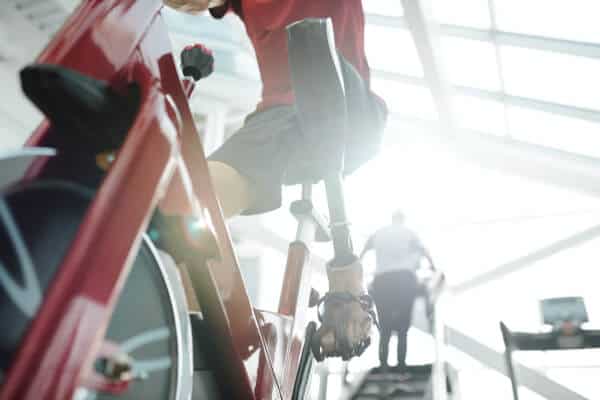When you’re looking for low-impact exercises, you should be thinking about activities that are not overly strenuous, involving sudden movements or any other jolting motion. Whether you’re looking for low-impact exercises due to injury, are going to the extra lengths to avoid getting injured, or just plain don’t like higher impact exercises, there are a wide variety of options that are available.
However, if you’re on this website, then you’re probably wondering specifically whether hiking is one of these low-impact exercises or not?
Hiking is considered to be a low-impact exercise. This is because you almost always have at least one foot on the ground, taking your weight. This helps to prevent putting extra strain on any particular part of your body.
Obviously, there will be times when you’re hiking that it might be necessary for you to make a small jump, for example, to get from one side of a stream to another, but this is an infrequent part of the exercise. By avoiding these jolting activities, you can help to minimize the potential risk to your joints and muscles.
IMPORTANT NOTE: While the below information is based on the current medical knowledge, it is important that you speak to a qualified professional, such as a doctor or certified fitness trainer, about your personal exercise circumstances.
What Is Considered A Low-Impact Activity?
While different sources quibble about the exact definition of what makes an activity low-impact, we can sum it up in the following way:
A low-impact exercise is any that minimizes the stress and pressure on your joints.
Whether these activities happen to be hiking through your local forest, swimming in a pool, or taking a spin class at the gym, the focus is on activities that are gentle on the body. Low-impact exercises tend to be less effective than high-impact exercises for losing weight, where you can incorporate explosive actions such as jumping squats. That being said, I don’t think anyone struggling to walk after a hard spin class will say that they aren’t effective.
It is worth noting that some consider activities such as swimming and cycling as “No-Impact” exercises.

What Is The Difference Between Low And High-Impact Exercises?
When you’re looking to improve your fitness, both high and low-impact exercises can be utilized but what is best for anyone depends on a variety of factors such as any pre-existing injuries, the level of fitness of the individual, and their current fatigue. With that being said, what are the actual differences between low and high-impact exercises?
Low-Impact Exercises
As covered above, low-impact exercises minimize the strain on the exerciser’s joints and muscles, whether through the distribution of weight (such as hiking) or by other means (such as swimming).
A lot of low-impact exercises have the opportunity to start with a lower intensity, then over time, make changes to the exercise to increase the intensity.
Some examples of low-impact exercises include:
- Hiking (of course)
- Yoga
- Cycling or spin classes
- Swimming or aqua aerobics
- Pilates
High-Impact Exercises
When we’re talking high-impact exercises, we’re not just talking about things like football but all exercises that rely on fast direction changes, both feet being off the ground at the same time and quickly varying strains on your body. These sorts of activities can take their toll on muscles and joints, which can lead to damage, either short or long term.
High-impact exercise is great for people that are in good health, maintain good form, and know their limits. As these exercises tend to involve large amounts of cardio and will boost your heart rate, they can be great if you’re looking to lose weight. Examples of these activities include:
- Running
- Skiing
- soccer
- Tennis
- Gymnastics
- Exercise classes (think burpees)

Reasons For Doing Low-Impact Exercise
Whether you just prefer tai chi to burpees, or you have existing medical conditions, there are plenty of reasons why someone may want to do low-impact exercises rather than other exercises. Some examples include:
- You just prefer it
- You want to add it to your existing exercise routine without increasing the strain on your body
- Medical conditions, such as:
- joint issues
- pregnancy
- being overweight
- arthritis
Can You Lose Weight With Low-Impact Exercise?
As mentioned about high-impact exercise is great for losing weight. However, this doesn’t mean that you won’t be able to lose weight from low-impact exercise; it will just take longer.
Over time, by building your strength, you will be able to increase the intensity, even activities such as hiking. This could be by hiking more challenging routes or by carrying greater loads (however, be careful not to overload yourself, or it will become bad for your back).
While celebrity diet and workout plans like to promise “the magical secret to rapid weight loss,” weight loss, in theory, isn’t complicated. By burning more calories than you consume, your body will need to get those calories from somewhere, usually your fat. Now those calories can be burnt from a game of soccer with your friends or by a nice long hike; it doesn’t make any difference.
Is Hiking A Strength Or Cardio Exercise?
As hiking is a prolonged form of exercise, that causes the exerciser to have a slightly raised heart rate throughout the exercise. While over time, it will help to strengthen and condition your muscles that is a happy by-product of the exercise.
How Can Hiking Strength Build?
While hiking is a low-impact exercise, it does not mean that someone cannot get hurt while doing it. Over time your body and muscles will build their strength from hiking. When people think about the muscles involved in hiking, they will likely think about the legs. However, many will have heard from new hikers how they feel they’ve worked out muscles they never knew they had. These tend to be the stabilizing muscles in someone’s body.
While having flat pavements to walk on is nice, it does mean that the human body doesn’t have to worry about all the different things that it needs to do to stabilize the body if it’s walking on uneven surfaces. Neglecting these can result in injury, which is something that everyone wants to avoid, but by working on these muscles, you’ll be able to build your strength and be able to take on longer and more challenging hikes.
Some examples of exercises that you can do from home to improve your strength for hiking include:
- Crunches: Having a strong core is crucial for a good balance
- Lunges: These are great for building strength in your glutes, but they are also great for strengthening the stabilizing muscles in your legs.
- Supermans: These can help to strengthen your lower back, which helps to stabilize your torso while you’re out hiking.
- Step-ups: this can also build strength on the legs and glutes
- Treadmill: Some cardio on this machine can increase the overall body strength.
We have a whole article on exercises you can use for hiking if you would like to know more about how to train for hiking.
When Can Hiking Be Considered Strenuous?
A person’s fitness level is the determinant of what is strenuous for them. A standard trail rating system in some parks can specify the level of difficulty a particular trail is considered. Therefore, it is essential to check a trail guide, signage, and park maps to confirm the level of difficulty before going on a hike on a particular trail. Also, hiking social media groups and chatrooms are a perfect place to get some honest life advice before embarking on your next hiking adventure. Let us take a look at the following trail features according to difficulty levels.
- Easy/simple: it has low or no grade, paved, there are no obstacles. Perfect for all hikers.
- Moderate: has small obstacles like stones and roots, graded at 10%, it is in good condition. The Hikers taking this trail should be in good condition.
- Challenging: Elevation is increased, in good condition, will take prolonged durations, and the obstacles are increased. The hikers taking this trail should be in good condition.
- Difficult: It is graded at 15%, it is in good condition, can take prolonged durations, and the obstacles are increased. Hikers taking this trail should be in excellent condition.
- It is very difficult: it is graded at 20%, the trails are not maintained, and may need some scrambling and climbing. Hikers taking this trail should be in excellent condition.
- Extreme: the trail is very challenging; it may be unmarked and unclear, the elevation levels are extreme, mountaineering and climbing are required. It may need a person hiking to have special survival tips. The hiker should be in excellent fitness level and experience.
Recommended Reading: If you’re interested in low-impact exercise then you might be interested in this article we have written about whether rucking is bad for your knees.
Wrapping Up
As we have covered in this article, hiking is a great low-impact exercise that allows for someone to build their strength and endurance over time. The low barrier to entry of hiking makes it a great choice for almost anyone looking to further their fitness journey. Hiking has a great many health benefits, from weight loss to stress relief.







